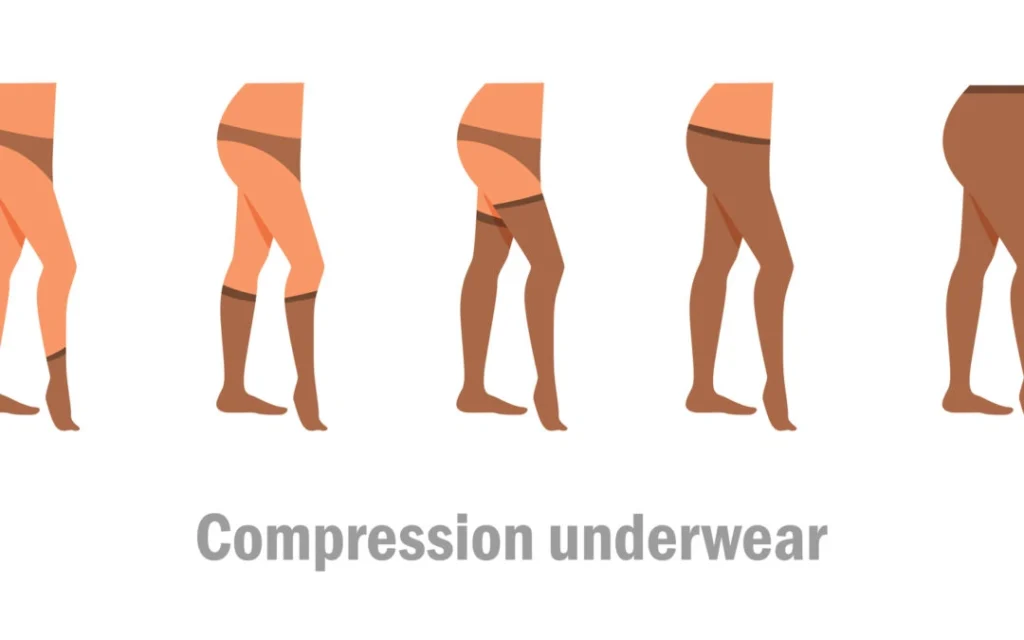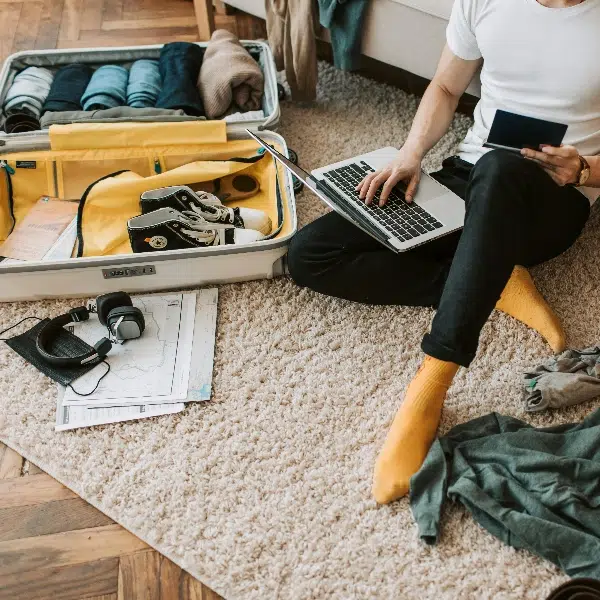Blood clots are life-threatening health emergencies that result in deep vein thrombosis (DVT) or pulmonary embolism (PE). This occurs when clots develop in the bloodstream, obstructing the blood flow, and pulmonary embolism and blood clots occur. In this article, we will dive into compression socks for blood clots, exploring their benefits, types, and usage.
Compression socks are stockings made with special features that help improve blood circulation in the legs to prevent the pressure and formation of clots. They act as guardians, ensuring blood flows freely, particularly in varicose veins, and minimizing the risk of clotting.
Understanding Blood Clots
Researchers found that blood clots are almost like little balls stuck inside blood vessels, which increases the risk of surgery in varicose veins. At times, they seem valuable, like when you are injured, and they help you not bleed too much.

Source: https://www.verywellhealth.com/overview-blood-clots-1745326
Yet sometimes, they can misbehave, particularly when they clump together in varicose veins and prevent blood circulation. Hey, that’s when risks like deep vein thrombosis (DVT) or pulmonary embolism (PE) start to occur – the last thing we want. So, what leads to the appearance of these bothersome clots?
Indeed, such things as long-time sitting (e.g., long flights), smoking, being overweight, or having some diseases such as cancer or heart disease can be risk factors and symptoms. Thus, it is paramount to look for these factors and take action to avoid clot formation!
Importance Of Prevention
Let’s discuss the importance of avoiding blood clots, shall we? Picture this: If the blood clots in varicose veins are not treated, such as deep vein thrombosis DVT, they can cause a lot of pain.
Deep vein thrombosis (DVT) and pulmonary embolism (PE) are serious conditions in which blood clots get right into your legs or lungs. There’s nothing fun about them. That’s why we focus on prevention! Wearing compression stockings or engaging in physical exercise can greatly reduce your symptoms of suffering from this unwanted pain.

Source: https://www.nhs.uk/conditions/deep-vein-thrombosis-dvt/
Therefore, consider it like a healthy deposit into your credit account—a small investment now in compression garments can avert the discomfort and risk of blood clots during lengthy flights in the future.
Role Of Compression Therapy
In compression therapy, people wear compression socks and garments that gently add pressure to the legs or lungs.
This squeezing action of your muscles helps eliminate the pooling of blood in the legs and improves the general flow of blood. Compression therapy is just a giant support system for your veins, allowing them to work better and save the long flights.
How Compression Socks Aid In Preventing Blood Clots
Let’s explore compression therapy and how those fantastic compression socks make magic to avoid blood clots and regulate blood flow!

Source: https://www.yashodahospitals.com/blog/unlocking-the-secrets-of-compression-stockings/
Increasing Circulation
The technology behind the compression socks provides gentle pressure to your legs and to your ankle, which helps your blood flow back to your heart.
This effectively prevents the blood from forming pools within your veins and reduces the risk of clotting. This way, your blood will keep flowing without clots sneaking in, thanks to the improving circulation caused by compression socks.
Supporting Vein Function
Through external assistance to your veins, compression socks help them perform better. Thus, sluggish or impaired blood circulation that could lead to blood clot formation is less likely. Consider compression socks as giving a push to your veins, which ensures their good shape and function, even when they face situations such as long sitting or standing, or long flights.
Reducing Swelling
Compression socks can reduce symptoms of swelling in your four legs, a sign of poor circulation. In addition, they are responsible for preventing inflammation, which further minimizes the risk of forming blood clots. Moreover, less swelling signifies much more comfort and mobility for you, reducing the risk of surgery!
Types Of Compression Socks
Alright, let’s break down the different types of compression socks you can choose from:

Source: https://cachevalleyvein.com/finding-the-right-compression-sock/
Calf-High Compression Stockings
Calf-high compression socks support your calves and squeeze in all the proper locations. Perfect for wearing each day to keep your legs feeling energized. They’re like a hug on your calves, helping with stream and maintaining muscle fatigue.
Knee-High Compression Socks
These compression socks are worn above the knee. They are convenient and contribute to circulation, thus avoiding lower leg swelling. Doctors often prescribe knee-high compression socks for people who may be sitting or standing for many hours, such as office workers, travelers, or athletes.
Thigh-High Compression Stockings
If you need more coverage, you can try graduated compression stockings up to your thighs. They reach up to your thighs, providing compression and overall leg support.
Thigh-high graduated compression stockings are usually beneficial in treating certain diseases, such as DVT and CVI, because they help improve blood flow in blood vessels, drain leg swelling, and reduce the risk of surgery.
Compression Pantyhose
People who are looking for thigh-cut compression stockings can choose pantyhose. This kind of compression goes from the skin of the toes to the waist, contributing to blood circulation in the lower body.
Compression pantyhose is suitable for people who experience symptoms of swelling or discomfort while sitting or standing for long periods, aiding them in getting rid of varicose veins and edema problems, especially in pregnant women.

Compression Sleeves
Sleeves, like compression stockings, are like socks without a foot part. They are made to give compression and support to each of your ankles and lower legs.
Compression sleeves are in vogue among athletes, particularly runners and cyclists, because they provide extra circulation, less muscle fatigue, and superior performance during training.

Open-Toe Compression Socks
A systematic review shows that compression socks with an open toe can be your choice if you choose sandals or shoes after a few hours of wearing them. They will have compression, enabling your toe to move for extra comfort.
The open-toe variant of compression socks is amazing for those who want to benefit from compression therapy without causing symptoms of swelling and discomfort in footwear decisions that result in surgery.
Choosing The Right Compression Socks

Assess Your Needs: First, find out why you need graduated compression stockings. Are you looking to reduce the risk of developing DVT blood clots when sitting or standing for extended periods? Reduce symptoms of swelling of your legs and the pressure in one leg to avoid surgery? Or enhance blood circulation during practice? Knowing your exact needs will help you filter through your choices. The recommended compression level for blood clots is typically 30-40 mmHg.
Consult a Professional: If you wonder what compression stockings and style would work best for you to prevent the formation of blood clots in the skin and leg, consult a healthcare professional. Considering your medical history and lifestyle, they can inform you about the most appropriate compression level and the type of socks you need to promote circulation in one leg and prevent major surgery on the skin or leg.

Try Them On: After limiting your selection, put on a few samples to see if they feel good. Ensure they’re tight enough and give enough support to maintain your movement to prevent DVT.
Consider Comfort and Style: In the end, consider the comfort and style of your body! Pick compression socks that fit well for a long time and match your personality and skin type. Ultimately, you will be wearing compression socks very frequently, thus making finding a pair you feel comfortable with fundamental.
Tips For Incorporating Compression Socks Into Daily Life
Let’s explore how you can add compression socks to your lifestyle to achieve the best results!
Wear Them First Thing In The Morning
Wear compression socks as soon as you wake up to prevent blood clots and swelling of the legs. Slide a clean pair of compression socks in the leg, start your circulation, and establish yourself for a day filled with comfort and support instead of an increased risk of DVT, swelling, discomfort, and surgery. It also has the benefit of reducing symptoms like swelling and skin irritation in your legs when you do different activities throughout the day.

Keep Them Handy At Work Or Travel
The National Institute of Healthcare Providers says that compression socks can be your best companion to prevent DVT and the risk of surgery if you spend most of the day sitting at a desk or flying with planes.
Make sure that you keep at least one pair of compression socks in your bag or desk drawer and put them on to stop the discomfort if you need extra anchoring. They will help you avoid symptoms like sore legs, even on those long days of travel or work.
Wear Them During Physical Activity
Refrain from feeling uncomfortable. Keep on being active! Whether working out in the gym, on the treadmill, or walking faster, wearing compression socks can help with blood flow, relieve muscle fatigue, help with treatment, prevent DVT, and keep you going throughout your activities.
Use Them For Recovery After Exercise
Wear compression socks before winding down for the evening to optimize your recovery after exercise. Whether you’re relaxing on the couch or preparing for bed, compression socks can significantly reduce the risk of DVT and alleviate swelling in the legs and skin.
The gentle compression will release muscle tension, calm you down, and prepare you for a good sleep. It is the best way to finish your day with comfort and peace.

With these tips, you’ll be well on your way to finding the perfect pair of compression socks to keep your legs happy and healthy and prevent post-thrombotic syndrome and cardiovascular disease!
The Last Say
Compression socks are like life savers for your legs and ankle; they help blood flow, promote vein functionality, and reduce swelling, with a life-threatening risk of DVT and surgery, venous thromboembolism, and life-threatening high risk of developing DVT like a superhero would.
There is a great diversity of them; you can pick from any of them according to your skin and body, like ones that reach your knees, thighs, and even your sleeves and socks. These help prevent blood clots, which are called deep vein thrombosis (DVT).
The range of compression stockings includes different lengths, such as knee-high, thigh-high, and calf-high, as well as sleeves according to skin type. Incorporating them into your everyday life is smart and beneficial, especially during activities that involve prolonged standing or sitting, as they help prevent swelling and reduce the risk of related complications.
And remember the basics: make sure that they fit tightly, take care of them, and use them right about your skin. With these tips, compression socks provide you with a healthcare professional you can trust to combat every blood clot.
🧐FAQs about Compression Socks For Blood Clots: Do They Really Help?
1. Do compression socks really help with blood clots?
Yes, compression socks can help manage blood clots by improving circulation and reducing the risk of clot formation.
2. When should compression socks be worn for blood clots?
Compression socks for blood clots are typically worn during the day, especially when you’re active and upright. It’s important to follow the guidance of your healthcare provider regarding the specific timing and duration for wearing compression socks.



